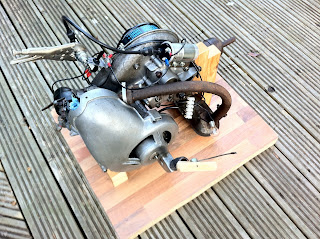I am exhausted.
But not so exhausted to investigate a large package that had arrived for me while I was away.
It was 7 weeks ago when I spotted a pair of Manurhin Scooter wheels for sale on the French website www.leboncoin.fr - this was about the time when I was realising that my own rear wheel was incorrect. I contacted the seller and thereby started an epic story of email negotiations and logistics.
The seller - Morgan - was based near Lyon (mid France) and didn't speak English. And I don't speak French but together we managed to communicate quite effectively via email and Google Translate.
Morgan wanted 80 euros for the pair of wheels. Although I didn't really need another front wheel, his looked better than mine in the photos so I agreed at 80 for the pair. He also had a pair of aluminum footrests for sale too, but at another 80 euros I had to decline.
Now I spend most of my life in front of a computer - I consider myself "always online". Morgan, I suspect however probably isn't. Replies could sometimes be a few (several?) days coming. So it was with great delight when a few days later I received an email from Morgan offering me the footrests at a 'discount' price of 45 euros for the pair. I gratefully took the offer and we started the (lengthy) process of working out how to 1) get the wheels and footrests from Lyon to Birmingham, and 2) make the payment transaction
I had a quick look at courier prices from the likes of Fedex and DHL and these looked to be around £120-150 - this was going to be be an expensive pair of wheels!
And so I thought I'd try AnyVan, the online delivery auction site. Within hours of posting my need, I had my first offer to collect and deliver - £300. Over the next few days various couriers bid down the price to a far more sensible sub-£100.
In the meantime, I was trying to pay Morgan. I was keen to pay at least a deposit in order to secure the sale. Morgan doesn't use PayPal but would accept a cheque or maybe a bank transfer. We spent a good couple of weeks trying to find a mutually acceptable payment method, and at one stage when emails were particularly slow in coming I thought that maybe it was all off, he'd either sold them elsewhere or had simply got fed up with the hassle of it all.
In the meantime, back to the courier; Offers were down to £60 and I was ready to accept, but had to apologise to the bidders that I couldn't commit as I hadn't actually bought the items yet... in fact I didn't even know if they still existed for me.
It was driver 'swift1' (mark) who first suggested that he could do a pay on collection for me if it would help facilitate the process. Unfortunately Mark couldn't make the time window that I needed (but I should say now that Mark was a superstar in doing his best to try and make this work - and if I could I would give him 100% feedback based on his efforts alone), and so eventually I found 'philbfc' (Phil) who was equally enthused to do his utmost to help me.
Eventually Morgan responded to my email;
"Sorry i didn't have time to give you answers. There's no problem for manurhin wheels they are for you"
I was mightily relieved and followed with a flurry of activity to arrange money and dates (doubly complicated by the fact that I wasn't going to be around to pay on receipt when the wheels were eventually delivered to my house)
 Between Phil and Morgan (while I was in Atlanta), they arranged a pay-on-collection at 11pm on Thursday evening as Phil was traveling through Lyon on his way back to the UK
Between Phil and Morgan (while I was in Atlanta), they arranged a pay-on-collection at 11pm on Thursday evening as Phil was traveling through Lyon on his way back to the UKThat night I received the following email. It warmed my heart;
Bonjour
Le colis est partie hier soir .
Le règlement a bien été effectuer .
Je suis également contant que les pièces soit pour une personne passionner .
Je compte sur vous pour redonner vie a ces Pieces et les remettre en belle état .
Hésitez pas pour m envoyé des photos de votre projet .
J espère que le colis arrivera bientôt chez vous.
Amicalement
Morgan
Saturday just gone (while I was in Cambodia) Phil dropped the package off at my house, and today within 15 minutes of returning from a grueling 21 hours traveling halfway round the World, I actually touched the wheels that I had first inquired to buy 7 weeks ago.
I was delighted :-)
They might not be the colour I need for my bike, but I reckon they are in such good condition that I wont have to do anything to the wheels, tubes, tyres or hubs to get my scooter up and running.
What a great christmas present (to myself ;-)
















































